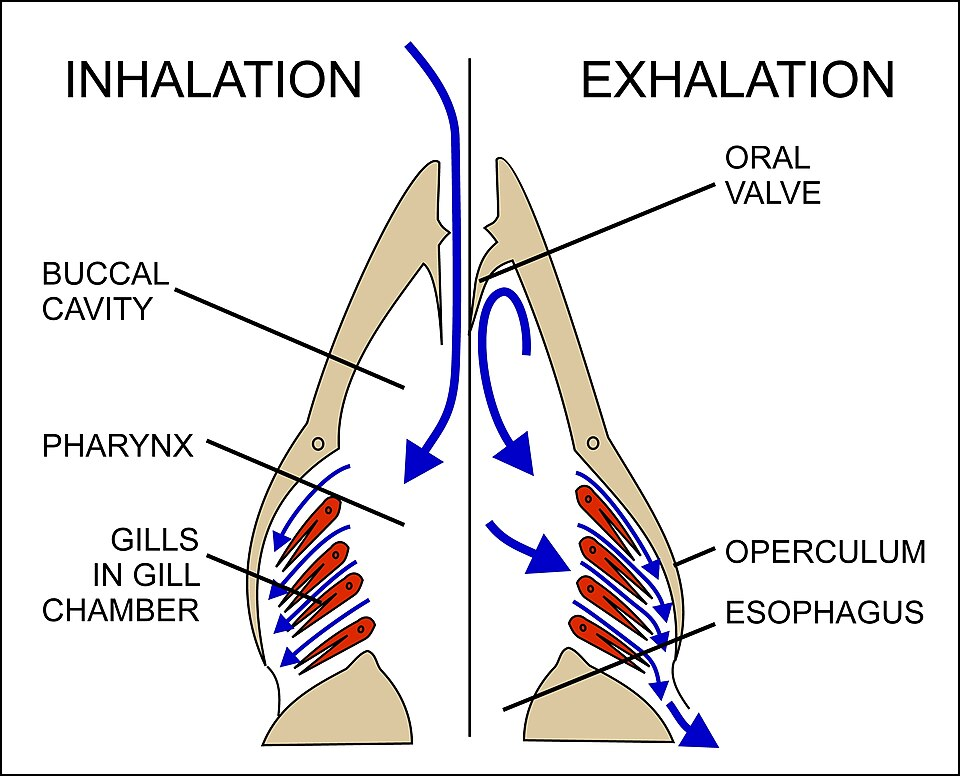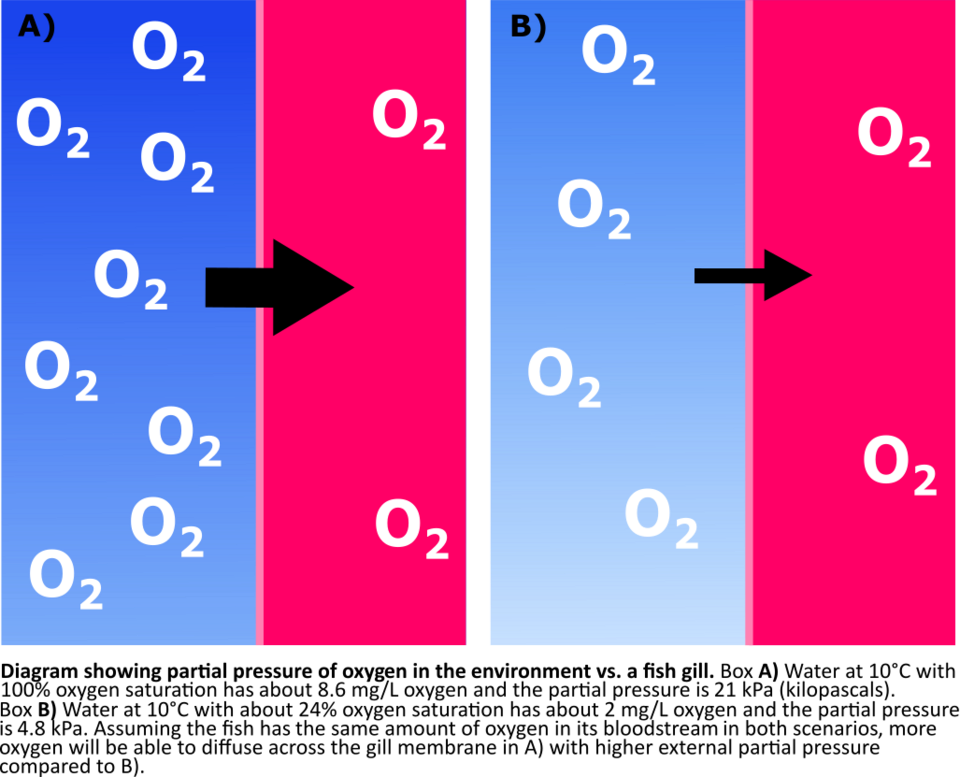OCR Specification focus:
‘Buccal cavity volume changes and operculum movement drive water over gill filaments and lamellae; countercurrent flow maintains a steep diffusion gradient for oxygen uptake.’
Ventilation and Gas Exchange in Bony Fish
Bony fish possess specialised structures and mechanisms to extract oxygen efficiently from water, an environment where oxygen concentration is far lower than in air. Their gills provide a large, thin, and well-ventilated surface, maximising oxygen absorption and carbon dioxide removal.
Structure of the Fish Gas Exchange System
Gills: The Primary Exchange Surface
Bony fish gills are highly adapted to maximise surface area and maintain steep concentration gradients.
Each fish has four pairs of gills located in a chamber on either side of the head.
Each gill is made up of gill arches, which support gill filaments.
Each filament is covered in numerous gill lamellae, which are thin, plate-like structures that greatly increase the surface area for diffusion.
Gill lamellae: Thin, flattened extensions of gill filaments that provide a large surface area for gas exchange and contain capillaries for diffusion of gases.
The lamellae are richly supplied with blood capillaries, and their thin epithelial layer ensures a short diffusion distance between water and blood. Together, these features make gills an efficient exchange surface.
The Ventilation Mechanism in Bony Fish
The Role of Buccal and Opercular Cavities
Bony fish use a two-pump ventilation system involving the buccal cavity (mouth) and opercular cavity (gill chamber covered by the operculum).
The process operates in a continuous cycle to maintain a one-way flow of water over the gills.
Step 1: Inspiration (Water Intake)
The fish opens its mouth.
The buccal cavity floor lowers, increasing the volume and decreasing the pressure within the cavity.
Water flows into the mouth from the external environment due to the pressure difference.
Step 2: Expiration (Water Flow over Gills)
The fish closes its mouth.
The buccal floor rises, decreasing cavity volume and increasing pressure.
Simultaneously, the opercular valve (a flap behind the gill cover) opens, and the opercular cavity expands.
Water is forced over the gills and exits through the opercular openings.
This coordinated action of the buccal pump and opercular pump ensures a constant, unidirectional flow of water across the gill surfaces, maintaining the diffusion gradient required for efficient gas exchange.
Operculum: A bony flap covering and protecting the gills, which helps control the flow of water over the gill surfaces during ventilation.
Water is drawn into the mouth as the buccal cavity expands and expelled as the operculum opens; this one-way flow ventilates the gills.

Horizontal section of a bony fish head illustrating inspiration (left) and expiration (right). Arrowed water paths show how the buccal and opercular cavities act as a two-phase pump to maintain continuous flow over the gills. Labels are minimal and focused on the flow direction, matching syllabus depth. Source.
Countercurrent Flow Mechanism
Maintaining the Diffusion Gradient
One of the most significant adaptations in bony fish is the countercurrent flow system between water and blood within the gills.
Water flows across the gill lamellae in the opposite direction to the flow of blood within the capillaries.
This arrangement ensures that water with a higher oxygen concentration always meets blood with a lower oxygen concentration.
As a result, diffusion occurs continuously along the entire length of the lamella, maintaining a steep concentration gradient for oxygen uptake.
Countercurrent flow: A mechanism where two fluids flow in opposite directions, maintaining a concentration gradient that maximises the efficiency of gas exchange.
Blood in the secondary lamellae flows opposite to water, establishing countercurrent flow that maintains a steep diffusion gradient.

Diagram showing oxygen partial pressure profiles for water and blood along a lamella during countercurrent exchange. Opposing flows keep a favourable gradient along the entire exchange surface, maximising O₂ uptake. The graphic focuses on gradient maintenance rather than extra physiological detail. Source.
If the water and blood flowed in the same direction (parallel flow), diffusion would reach equilibrium halfway along the lamella, and oxygen uptake efficiency would drop drastically.
Adaptations for Efficient Gas Exchange
Bony fish demonstrate several key structural and physiological adaptations to ensure efficient gas exchange in water:
1. Large Surface Area
The presence of numerous filaments and lamellae increases the total surface area for diffusion.
This compensates for the low oxygen concentration in water.
2. Short Diffusion Distance
The epithelial cells of the lamellae and the capillary walls are extremely thin (often only one cell thick).
This minimises the diffusion pathway, allowing for rapid gas exchange.
3. Steep Concentration Gradient
The ventilation system continually brings in oxygenated water.
The circulatory system transports deoxygenated blood to the gills and oxygenated blood away, maintaining a high concentration gradient between water and blood.
4. Unidirectional Water Flow
The buccal-opercular pumping system ensures that water moves in one direction only, preventing mixing of oxygen-rich and oxygen-poor water.
5. Countercurrent Exchange
The opposite flow of water and blood maintains an optimal diffusion gradient along the entire lamellar surface.
6. Efficient Circulatory System
Fish have a single circulatory system, with blood flowing from the heart to the gills, then to the rest of the body.
The heart pumps deoxygenated blood to the gills at high pressure, ensuring continuous delivery to the exchange surface.
Oxygen and Carbon Dioxide Exchange
Diffusion of Oxygen
Oxygen from the water diffuses across the lamellar epithelium into the blood in the gill capillaries, where it binds to haemoglobin in red blood cells.
Oxygenated blood then travels from the gills to body tissues via the systemic circulation.
Diffusion of Carbon Dioxide
Carbon dioxide produced by respiring cells diffuses from blood into the water flowing over the gills.
Because CO₂ is more soluble in water than O₂, its removal is highly efficient even at low concentration gradients.
Diffusion: The passive movement of molecules from an area of higher concentration to an area of lower concentration, down a concentration gradient.
This constant exchange maintains homeostasis in the fish’s internal environment, ensuring that aerobic respiration can proceed effectively in all tissues.
Summary of Key Processes (For Conceptual Clarity Only)
Buccal cavity lowers → water enters.
Mouth closes, buccal cavity raises → water forced over gills.
Operculum opens → water exits, maintaining continuous flow.
Countercurrent flow between blood and water ensures maximum oxygen uptake.
Thin lamellae and rich capillary supply shorten diffusion distance and sustain gradient.
FAQ
As water temperature rises, the amount of dissolved oxygen decreases, making oxygen uptake less efficient.
To compensate, fish may:
Increase ventilation rate by moving their buccal and opercular pumps faster.
Increase heart rate to maintain oxygen delivery to tissues.
However, warmer water also increases metabolic rate, further increasing oxygen demand. This combination can limit performance and survival if the fish cannot meet respiratory needs.
Water is denser and more viscous than air, so moving it in and out would require much more energy.
A unidirectional flow means:
Water passes once over the gills, reducing resistance.
A constant oxygen supply is maintained without mixing oxygen-rich and oxygen-poor water.
This system ensures efficient gas exchange with minimal energy expenditure.
Gill filaments rely on water for support and gas exchange; without it, they stick together and collapse.
Some amphibious fish possess:
Rigid gill arches or reinforced filaments to maintain structure in air.
Accessory respiratory organs such as vascularised mouth linings or skin for limited oxygen uptake.
These adaptations are specialised and not typical of most bony fish.
Active species often use ram ventilation, swimming with their mouths open to force water over the gills.
Key features include:
Continuous forward movement keeps water flowing without buccal pumping.
Reduced need for opercular movements saves energy during high-speed swimming.
Sedentary species, such as cod, rely on the buccal–opercular pump to move water while stationary.
Beyond their large surface area, lamellae have several fine-scale features:
Extremely thin epithelial layers (1–2 cells thick) reduce diffusion distance.
Rich networks of capillaries ensure rapid oxygen removal and CO₂ delivery.
Countercurrent flow across each lamella maintains the steepest possible oxygen gradient.
Together, these micro-adaptations make the lamellae one of the most efficient respiratory surfaces in the animal kingdom.
Practice Questions
Question 1 (2 marks)
Explain why the countercurrent flow system in the gills of a bony fish results in efficient oxygen uptake.
Mark scheme:
1 mark: For stating that water and blood flow in opposite directions across the gill lamellae.
1 mark: For stating that this maintains a steep diffusion gradient along the entire length of the lamella, allowing continuous diffusion of oxygen into the blood.
Question 2 (5 marks)
Describe the sequence of events that occur during ventilation in a bony fish and explain how these actions ensure effective gas exchange.
Mark scheme:
1 mark: Mouth opens and buccal cavity floor lowers, increasing volume and reducing pressure so water enters the mouth.
1 mark: Mouth closes and buccal cavity floor rises, reducing volume and increasing pressure, forcing water over the gills.
1 mark: Operculum opens and opercular cavity expands, maintaining a unidirectional flow of water across the gills.
1 mark: Continuous flow of oxygenated water across gill lamellae maintains a steep oxygen concentration gradient.
1 mark: Short diffusion distance and large surface area of lamellae enable rapid gas exchange between water and blood.

